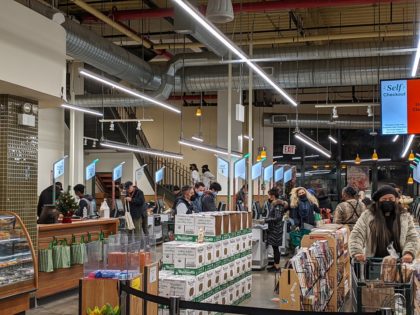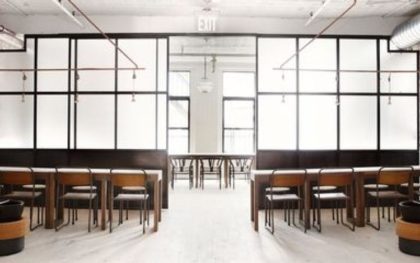Seen & Heard: DIY at Whole Foods
SELF-CHECKOUT EXPANSION AT WHOLE FOODS
N. caught the installation of the new self-checkout tellers at Whole Foods on the West Street — there are now only a few manned stations left on that side. I have a few complaints about the lack of staffing at the registers in the store — lines seem longer to me by a bit but not terribly so?
MAPPLETHORPE CELEBRATED IN DANCE
BPC resident Mary Amsterdam has produced a movement-based installation by Haus of Pvmnt, a performance company based in Brooklyn, that will take place at the NY City Culture Club gallery located in the Oculus on Monday, Dec. 6, 8p. (She is also an advisor to the company.) The performance will be based on the life and work of Robert Mapplethorpe. Tickets are here.
TENOVERTEN HAS CLOSED ITS TRIBECA SALON
TenOverTen has closed its Tribeca studio, but still has salons in Fidi — at 121 Fulton between Nassau and William in pic above — and on the UES.
ARROYO HAS MOVED TO SOHO
The Arroyo Studio hair salon that was at 200 Hudson and Canal has closed our location but has a studio open by appointment just up the street at 180 Varick and another in Brooklyn. Find them here.
















I’m fairly sure that now that WF opened many more self checkout lanes that they’ve changed to item count for them from “15 or less” (or something like that) to unlimited. So if you’re willing to the work you can skip the attended lines.
So, if stores are moving to self-checkout, that means the customer is getting less service for the money paid, and the grocer’s costs go down by laying off all those workers. So grocery prices should go down accordingly, right?
Grocery store margins are typically 1% of sales. It is a working-capital-intensive business with high fixed costs. The business is about continuously cutting costs, applying technology, and buying in high volumes to avoid increasing prices.
How much do you expect prices to be cut in an environment where the grocer’s alternative is raising prices because wages are rising because of an inability to find workers?
^^^what he said^^^
I’m always amazed by people who know nothing about the economics of a particular business segment spout off about how/why they should be lowering prices.
Then again, everything’s free if you think about Bezos while you mimic the sound of the scanner to make it look like you’re paying for everything
Thank you for the info, James. I was not aware that margins are that tight.
astonishing—there is a worker SHORTAGE :)
I would have been prone to say that WF/Amazon was being greedy by replacing workers, but this is another symptom of post Covid life. Managers have had to fill in at registers due to lack of staff, and half the “customers” you see in the store are Amazon Prime delivery workers.
When I chat with cashiers at checkout they tell me since Amazon owns, they’re really not hiring WF cashiers as they’re trying to make it totally Amazon Prime Delivery mode and that staff is often quitting because of how overworked they are at registers with those insane lines. It’s sad situation.
I have decided to stop patronizing Whole Foods. The Amazon model does not work for me. Their trucks are in front of our building all day, with harried workers rushing through their orders, then being replaced with a completely different crew. I find Amazon’s twirled plastic wrap in our community garden. The lobby of our building fills up every day with Amazon orders, putting retail stores out of business. This may be the way things are now, but I prefer not to. Including self checkout. Trader Joe’s, Target, and local market on Reade Street will have to fill in. Their cashiers are great! And I don’t mind going to stores and buying things there. Marshalls, anyone?
paakre@gmail.com
The sad truth is that post covid this just makes more sense. As a current leader with the company I can say that there are several variables contributing to Whole Food’s future. Foremost, as a company we aren’t competitive in the market for entry level positions. Cost of living has been steadily rising and with Amazon’s entrance a substantial change was made for entry level positions but nothing has changed for those positions and on the other end of the spectrum I can confirm that nothing has changed for management level positions either. If we want to increase retention, team member morale/happiness, as well as customer service quality a change has to be made. With that being said, it’s difficult to find people who want to work, will actually work, and who will stay. Retention is at it’s worst in years and finding new team members who are willing to stay more than a couple of months, which is how long it takes to become even marginally comfortable regarding the tasks that must be completed in most roles, has been all but fruitless. We live in a different world than we once used to live in and we must all accept that things are going to change, some for the good and some for the worse.
And FYI, grocery prices will continue to rise as logistics and sourcing for materials, goods, and staffing become more difficult so I would accept this as the “new norm”.
Thank you for the explanation. So it sounds like current grocery prices are unsustainable. If so, has this already been so even pre-pandemic? It seems like competition must have forced a race to the bottom in pricing already for a while if margins are so slim.
This study shows US grocery (and dining out) prices relative to that of other countries in the world… Many European countries have higher prices:
https://www.bayut.com/mybayut/dining-out-eating-in-around-the-world/
Although some have argued that the prices should be higher still if costs were properly factored in, including environmental costs, and reforms were made to the labor practices affecting the workers in the food industry.
This article was pre-pandemic already noting the price war:
The Real Cost of Cheap Groceries
https://fortune.com/longform/cheap-groceries-food-farmers-laborers/
Germany’s prices are lower than US prices, but this argues that this is deceptive, as the environmental cost is not factored in:
Why cheap groceries will hurt us all in the long run
https://www.dw.com/en/food-sustainability-organic-discounter-cheap-environmental-costs-prices-factory-farming/a-54919142
Then there are government subsidies which presumably selectively reduce pricing as well.
The problem with Prime delivery is that the heavy items which make me use it are rarely in stock in anything close to the quantities I need, so I end up paying the delivery fee, and the tip on the original amount, and I don’t get what I ordered.
It’s not like they’re out of stock occasionally, they NEVER have more than a handful around, nor do they have adequate substitutes. And each is already $2 more than at Trader Joe’s.
Instead of being a mutual contractual agreement, it ends up being Amazon has no obligation to fulfill the terms.
I’ll take a cab from Trader Joe’s.
While supply issues due to supply chain break down are still a very real thing the problem most likely is that auto replenish, which is essentially the system that orders, will only order based on past sales projections and will not account for bulk orders. That being said fulfillment of orders, replacements for items that aren’t found and/or not in stock for quantities that are required, puts you in the hands of a worker who is performance is being monitored in how many units per hour that shop. Asking the customer for a their preferred replacement, searching for items not stocked, and finding actual viable replacements all take time which adversely effect that team member’s metrics. Which are monitored by everyone from their direct leadership on up the food chain to regional. Essentially what you have is a person who is worried about losing their job over taking too much time to find your liquid detergent. You’d save yourself the fee and trouble if you just picked up your order or went to the store and had them hell you out to your car.
UNIQ LO on Broadway now has self checkouts only. Coming soon to most large chains.
I was at Whole Foods yesterday and I like the self service check out but the line was so long. If they go this route then they. will have to add more stations…or I won’t go there. I like Fresh Direct.
I guess it depends on the time of day you go shop. I went around 8:30am this morning to get my short ribs that are on sale this week. Walked straight to self check in area and didn’t have to wait. It was just in and out. Usually lines are long during lunch time and after work in the evenings. One concern about self check outs for folks that don’t speak English and only use cash (some of my elderly family members are like that). Hope companies at least keep one or two cashiers and not replace 100% with self check outs…
Re Whole Foods
Two days ago I had occasion to go up to Audubon Terrace at 155th St. What a wonderful, lively area of the city that is! Supermarkets! Hardware stores! Small shops selling all kinds of useful things! Diners where you can get a hamburger at a reasonable price! Not a single overpriced restaurant in the street! A real, vibrant city neighborhood.
Then back down to gentrified Tribeca, where you can look in vain for all such things. It’s sad.
Quite simple to move apartments if Tribeca is not up to snuff in your view, no?
Setting aside the economics and rationale, I must say the self checkout experience is far from easy. Phone in one hand, my handbag in another, I find it all awkward. And I don’t have a degree in filling bags. My bag of grapes got crushed under the 360-brand water bottles last time. Poor grapes. Poor me. Pathetic.
I kind of hoped they’d at least go for Amazon Go style “just walk out” technology. I’d probably spend more money at WF if I wasn’t always hedging the best time to visit.
Go ahead and just walk out with your order. No one will stop you just like no one is stopping the thieves.